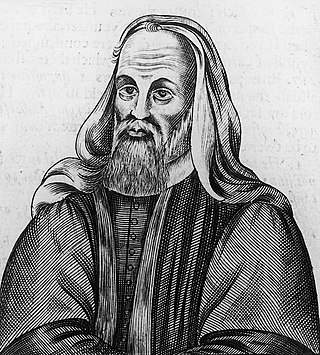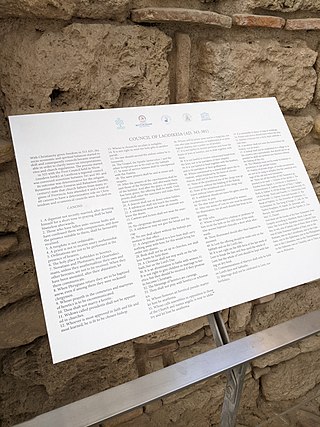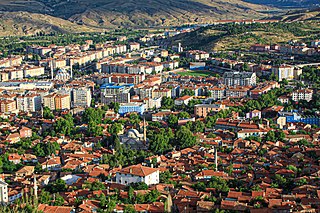
The Council of Chalcedon was the fourth ecumenical council of the Christian Church. It was convoked by the Roman emperor Marcian. The council convened in the city of Chalcedon, Bithynia from 8 October to 1 November 451 AD. The council was attended by over 520 bishops or their representatives, making it the largest and best-documented of the first seven ecumenical councils. The principal purpose of the council was to re-assert the teachings of the ecumenical Council of Ephesus against the heresies of Eutyches and Nestorius. Such heresies attempted to dismantle and separate Christ's divine nature from his humanity (Nestorianism) and further, to limit Christ as solely divine in nature (Monophysitism).

Pope Siricius was the bishop of Rome from December 384 to his death. In response to inquiries from Bishop Himerius of Tarragona, Siricius issued the Directa decretal, containing decrees of baptism, church discipline and other matters. His are the oldest completely preserved papal decretals. He is sometimes said to have been the first bishop of Rome to call himself pope.

The Council of Ephesus was a council of Christian bishops convened in Ephesus in AD 431 by the Roman Emperor Theodosius II. This third ecumenical council, an effort to attain consensus in the church through an assembly representing all of Christendom, confirmed the original Nicene Creed, and condemned the teachings of Nestorius, Patriarch of Constantinople, who held that the Virgin Mary may be called the Christotokos, "Christ-bearer" but not the Theotokos, "God-bearer". It met in June and July 431 at the Church of Mary in Ephesus in Anatolia.
Priscillian was a wealthy nobleman of Roman Hispania who promoted a strict form of Christian asceticism. He became bishop of Ávila in 380. Certain practices of his followers were denounced at the Council of Zaragoza in 380. Tensions between Priscillian and bishops opposed to his views continued, as well as political maneuvering by both sides. Around 385, Priscillian was charged with sorcery and executed by authority of the Emperor Maximus. The ascetic movement Priscillianism is named after him, and continued in Hispania and Gaul until the late 6th century. Tractates by Priscillian and close followers, which were thought lost, were discovered in 1885 and published in 1889.

Pelagius was a Romano-British theologian known for promoting a system of doctrines which emphasized human choice in salvation and denied original sin. Pelagius was accused of heresy at the synod of Jerusalem in 415 and his doctrines were harshly criticized by Augustine of Hippo, especially the Pelagian views about mankind’s good nature and individual responsibility for choosing asceticism. Pelagius especially stressed the freedom of human will. Very little is known about the personal life and career of Pelagius.

Severus the Great of Antioch, also known as Severus of Gaza or the Crown of Syrians, was the Patriarch of Antioch, and head of the Syriac Orthodox Church, from 512 until his death in 538. He is venerated as a saint in the Oriental Orthodox Church, and his feast day is 8 February.

The Council of Laodicea was a regional Christian synod of approximately thirty clerics from Asia Minor which assembled about 363–364 in Laodicea, Phrygia Pacatiana.

The Synod of Elvira was an ecclesiastical synod held at Elvira in the Roman province of Hispania Baetica, now Granada in southern Spain. Its date has not been exactly determined but is believed to be in the first quarter of the fourth century, approximately 305–6. It was one of three councils, together with the Synod of Arles (314) and the Synod of Ancyra, that first approached the character of general councils and prepared the way for the first ecumenical council. It was attended by nineteen bishops and twenty-six presbyters, mostly resident in Baetica. Deacons and laymen were also present. Eighty-one canons are recorded, although it is believed that many were added at later dates. All concern order, discipline and conduct among the Christian community. Canon 36, forbidding the use of images in churches, became a bone of contention between Catholic and Protestant scholars after the Protestant Reformation.

The Quinisext Council, i.e., the Fifth-Sixth Council, often called the Council in Trullo, Trullan Council, or the Penthekte Synod, was a church council held in 692 at Constantinople under Justinian II. It is known as the "Council in Trullo" because, like the Sixth Ecumenical Council, it was held in a domed hall in the Imperial Palace. Both the Fifth and the Sixth Ecumenical Councils had omitted to draw up disciplinary canons, and as this council was intended to complete both in this respect, it took the name of Quinisext.

Çankırı, historically known as Gangra, is a city in Turkey, about 140 km (87 mi) northeast of Ankara. It is situated about 800 m (2500 ft) above sea level. It is the seat of Çankırı Province and of Çankırı District. Its population is 90,564 (2021).
In the Catholic Church, a religious profession is the solemn admission of men or women into consecrated life by means of the pronouncement of religious vows, typically the evangelical counsels.
The Twelfth Council of Toledo, held in Toledo, Spain, was initiated on 9 January 681 by the Visigothic King Erwig, who was elected king in 680. One of its first actions was to release the population from the laws of Wamba and recognise Erwig, anathematising all who opposed him.

Paphnutius of Thebes, also known as Paphnutius the Confessor, was a disciple of Anthony the Great and a bishop of a city in the Upper Thebaid in the early fourth century. He is accounted by some as a prominent member of the First Council of Nicaea which took place in 325. Neither the name of his see nor the precise date of his death are known.
Arles in the south of Roman Gaul hosted several councils or synods referred to as Concilium Arelatense in the history of the early Christian church.
The History of the Eastern Orthodox Church is the formation, events, and transformation of the Eastern Orthodox Church through time.

In the history of Christianity, the first seven ecumenical councils include the following: the First Council of Nicaea in 325, the First Council of Constantinople in 381, the Council of Ephesus in 431, the Council of Chalcedon in 451, the Second Council of Constantinople in 553, the Third Council of Constantinople from 680–681 and finally, the Second Council of Nicaea in 787. All of the seven councils were convened in modern-day Turkey.

In the liturgical traditions of the Catholic Church, the term ordination refers to the means by which a person is included in one of the holy orders of bishops, priests or deacons. The teaching of the Catholic Church on ordination, as expressed in the 1983 Code of Canon Law, the Catechism of the Catholic Church, and the apostolic letter Ordinatio sacerdotalis, is that only a Catholic male validly receives ordination, and "that the Church has no authority whatsoever to confer priestly ordination on women and that this judgment is to be definitively held by all the Church's faithful." In other words, the male priesthood is not considered by the church a matter of policy but an unalterable requirement of God. As with priests and bishops, the church ordains only men as deacons.

Christianity in late antiquity traces Christianity during the Christian Roman Empire — the period from the rise of Christianity under Emperor Constantine, until the fall of the Western Roman Empire. The end-date of this period varies because the transition to the sub-Roman period occurred gradually and at different times in different areas. One may generally date late ancient Christianity as lasting to the late 6th century and the re-conquests under Justinian of the Byzantine Empire, though a more traditional end-date is 476, the year in which Odoacer deposed Romulus Augustus, traditionally considered the last western emperor.
The history of Eastern Orthodox Christian theology begins with the life of Jesus and the forming of the Christian Church. Major events include the Chalcedonian schism of 451 with the Oriental Orthodox miaphysites, the Iconoclast controversy of the 8th and 9th centuries, the Photian schism (863-867), the Great Schism between East and West, and the Hesychast controversy. The period after the end of the Second World War in 1945 saw a re-engagement with the Greek, and more recently Syriac Fathers that included a rediscovery of the theological works of St. Gregory Palamas, which has resulted in a renewal of Orthodox theology in the 20th and 21st centuries.
Syneisaktism is the practice of "spiritual marriage", which is where a man and a woman who have both taken vows of chastity live together in a chaste and non-legalized partnership. More often than not, the woman would move into the house of the man, and they would live as brother and sister, both committed to the continuation of their vows of chastity. The women who entered into a spiritual marriage were known as subintroductae, agapetae, and syneisaktoi. This practice emerged around the 2nd century CE, and survived into the Middle Ages, despite being condemned by numerous church leaders, writers, and councils.












